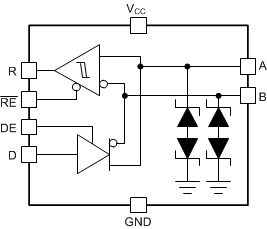SLLA639 May 2024 THVD1419 , THVD1429 , THVD1439 , THVD1449 , THVD2419 , THVD2429
3 Integrated Surge Protection and the THVD14x9 Family of Devices
With a basic understanding of how surge protection works on the RS-485 bus, the next question a designer needs to be asking is there a better option to help simplify the design while also maintaining a well-protected system? Fortunately, there is a design to this question – integrated surge protection in an RS-485 device. Considering that at the heart of any surge protected RS-485 communication node there is a TVS diode that helps clamp the bus voltage during transient overvoltage events a logical next step is to integrate the TVS diode internal to the RS-485 device. TI and the THVD14x9 family of devices was created to fill this need by integrating the simple protection design into the transceiver package.
 Figure 3-1 THVD14X9 Family of Devices
Functional Block Diagram
Figure 3-1 THVD14X9 Family of Devices
Functional Block DiagramThere are two major benefits from replacing the discrete protection scheme in favor of the integrated design. The first is ease of design - considering non-surge protected RS-485 devices do not have any specific surge rating attached to them the protection network must be rated for the incoming surges as well as respect the voltage ratings on the transceiver which presents the design challenge of converting surge waveforms into peak voltages seen by the transceiver. However, an integrated design such as a device in the THVD14x9 family from TI helps solves this problem by testing in accordance with IEC 61000 4-5 which standardizes the surge generator as well as the characteristics of the surge waveform.
 Figure 3-2 Surge Test
Characteristic
Figure 3-2 Surge Test
CharacteristicFigure 3-2 shows the normalized waveforms for both Open Circuit Voltage and Short Circuit Current. Figure 3-2 also shows the repetition rate in a standard surge test. This standard is a very common way to evaluate surge protection across multiple types of protection devices. In the traditional discrete implementation the transceiver has no rated surge protection – yielding another unknown that the designer must determine, but with an integrated surge device with an IEC 61000 4-5 rating the designer can immediately know what level of surge the device is rated for. An example of this is the THVD1419 which has an IEC 61000 4-5 rating of ±2.5kV. However, if looking at the discrete implementation the protection rating on the diode does not necessarily translate 1:1 to the protection rating of the node if the diode clamps too high at the rated surge voltage. Using an integrated surge device alleviates this risk by giving the transceiver a protection rating.
The next major benefit of using an integrated surge design is size reduction. Due to process and technological improvements over time the RS-485 transceiver as well as protection diodes can fit an in industry standard 8-pin SOIC device - which takes up approximately 19.16 mm^2 of board space. If using a common RS-485 diode for a discrete design with the standard SOIC package there can be an increase of about 50% for the design size. This is avoided when using the integrated design. Even if more robust protection is needed, such as TBUs and MOVs, the integration of the TVS diode can still reduce overall design size even in systems that require additional external protection.
While the two major benefits of using an integrated surge, device are clear – there is one downside. The downside is that there is a lack of flexibility when using the integrated design. While using the integrated design can trim down the unknowns for the design to determine, it also limits the options the design has when implementing a system. The THVD14x9 family is still largely bound by standard RS-485 limitations – meaning a more standard common mode range – which for the THVD14x9 family is ±12V. This is generally acceptable in many systems, but for systems with large ground currents or large distances between nodes the ±12V common mode range may not be enough for proper communication to occur in these systems. Another example to highlight this issue is the protection rating – if a higher protection rating than offered is needed there is most likely a discrete implementation that can meet the design goal which renders paying a premium for an integrated design not the best path forward. While this still shows that the integrated surge protection on standard RS-485 devices is very beneficial for more typical applications it does fully cover the application space of protected RS-485. However, one of these issues has been solved from TI’s latest surge protected RS-485 offerings – the THVD24x9x family of devices.